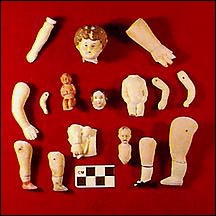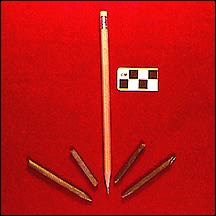Last updated: March 15, 2024
Article
Playthings of the Past
Introduction
Toys hold a fascination for children of all ages. Many an hour has been whiled away in play with a favorite toy. The making of toys has evolved from the simple to the complex. By the 1400s toy making had become an industry in its own right. This is particularly true in Germany where, as early as the fifteenth century, guilds had been organized among toy makers. Toy makers began establishing their trade in America by the early nineteenth century. By the end of this century, factories were mass-producing toys, which were then sold in specialty shops. Now, toys are offered for sale in specialty shops, department, discount, and grocery stores, the internet, and even given away as premiums in fast food restaurants.
Just like today, children of the past often took their playthings outside, inevitably misplacing some of them. Fabric dolls with delicate porcelain legs and arms would slip through their mothers' arms and shatter on the sidewalk, gaming pieces would be lost in the grass, marbles would roll through the wooden slats on the porch, seemingly never to be seen again. While the materials used to make toys have evolved over time, the general types of playthings available has changed remarkably little.
Children's Dishes

NPS
Today, children's cups and plates are usually made of plastic. These child-sized dishes, however, are ceramic. Often, children's dishes were decorated with proverbs, nursery rhymes, or the alphabet. The plate pictured here was recovered from an excavation at Fort Washington, on the Potomac River in Southern Maryland. The plain white mug was recovered near the Washington Monument in Washington, D.C. Both of these items date roughly to the late nineteenth century.
Tea Set

NPS
Children have always enjoyed imitating the behavior of their parents. The custom of tea drinking became increasingly widespread in the late eighteenth and early nineteenth centuries. Accordingly, miniature tea sets, sized for children's hands or for their dolls, were popular throughout the nineteenth century. These tiny cups, saucers, and teapot lids were recovered in Rock Creek Park, Harpers Ferry National Historical Park, and sites near the Washington Monument in downtown Washington, D.C.
Dominos

NPS
Dominos can be traced back to twelfth century China, though there is no record of them in European history until the middle eighteenth century. The game, as we know it, appeared around 1750 in Italy and France, eventually spreading throughout Europe and to the United States. Dominos became a favorite parlor game in the U.S. in the nineteenth century. These three examples, carved of bone and ivory, were recovered from sites in Harpers Ferry National Historical Park.
Dolls

NPS
Dolls can be made from any number of materials. Rags, wooden spoons, or corn husks were often fashioned into human figures, brought to life through the imagination of a child. Unfortunately, organic materials do not hold up very well underground. Porcelain, however, usually survives relatively intact.
Porcelain doll parts first became widely available in Europe around 1820. The doll-making industry established in southern Germany supplied porcelain doll parts for most of the world during the early to middle nineteenth century. The period from 1860 to 1890 was the heyday of the elaborately dressed fashion doll. Germany continued to be the world center of doll production until the early twentieth century.
These porcelain doll heads, arms, and legs would have been attached to a stuffed, fabric body. This type of doll dates primarily to the late nineteenth and early twentieth century. They were recovered near the Washington Monument in downtown Washington, D.C., Rock Creek Park, and Harpers Ferry National Historical Park.
Pencils

NPS
The history of marking and writing instruments goes far back into the past. Today we use wooden and graphite pencils like the one in the center of this photo. The earliest ancestor of the graphite pencil dates to around 1400. During the nineteenth century, pencils of soft slate, like the ones pictured here, were commonly used to write on sheets of harder slate. Children of the past used slate pencils and slate boards to practice their "lessons". Once completed, the slate could be wiped clean and used again and again. These examples were recovered from Rock Creek Park.
Harmonicas

NPS
The history of marking and writing instruments goes far back into the past. Today we use wooden and graphite pencils like the one in the center of this photo. The earliest ancestor of the graphite pencil dates to around 1400. During the nineteenth century, pencils of soft slate, like the ones pictured here, were commonly used to write on sheets of harder slate. Children of the past used slate pencils and slate boards to practice their "lessons". Once completed, the slate could be wiped clean and used again and again. These examples were recovered from Rock Creek Park.

NPS
Harmonicas are cheap, portable musical instruments that can be played almost anywhere. While there are professional harmonica players, this instrument has chiefly been thought of as a child's toy or an amateur's pastime instrument. The harmonica, produced first by Friedrich Buschmann of Berlin in 1821, consists of a metal reed plate set in a wooden frame. This wooden support usually deteriorates underground, though the metal plate often survives. These examples were made of cupric alloy, probably brass, and are shown in varying states of decay. These harmonica parts were recovered from the backyard of a row-house complex excavated in Harpers Ferry National Historical Park.
Marbles

NPS
Playing marbles has long been a popular pastime for children. Toy marbles have been found on archeological sites in Europe and North Africa dating from the second century A.D. The game of marbles has been played by children in Europe from at least the 1400s. In the sixteenth century, several cities in Europe introduced punishment for children playing marbles in the streets. One English village went so far as to authorize the use of a cat o' nine tails on boys "who played at marbles under the fish stand and refused to be warned off." Today's marbles are made almost exclusively of glass. However, marbles in the past have been made of glass, ceramic, or stone. These examples were collected from the Old Stone House in Rock Creek Park.
Toy Guns

NPS
Toys mimic the world of adults. Miniature weapons, including toy swords, pistols, and rifles, have been popular through time for children's war games. The predecessors of today's plastic ones, these metal toy guns were recovered from the Old Stone House in Rock Creek Park and Manassas National Battlefield Park.
Modern Toys

NPS
Artifacts do not have to be hundreds of years old to reveal facts about the area from which they were recovered. This plastic figure from the Planet of the Apes movie series, popular in the 1960s and 1970s, was recovered from an archeological site located on the Oxon Hill Farm in Maryland. While its historical value is questionable, the recovery of a modern object from the soil immediately surrounding a nineteenth century building tells archeologists that the ground has been disturbed and that the discrete soil layers that build up over time are probably mixed together.
